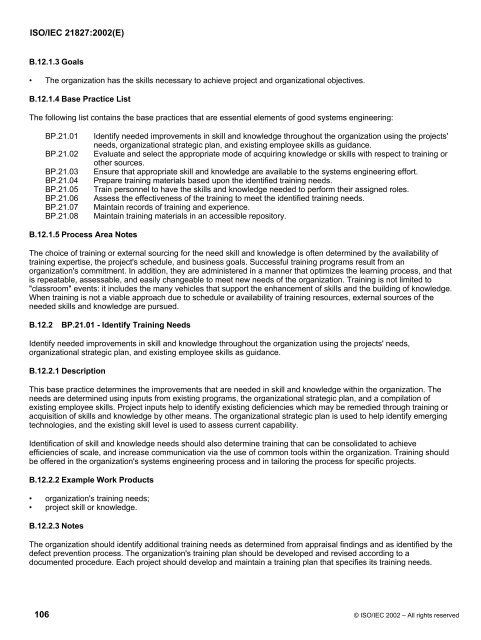ISO/IEC 21827
ISO/IEC 21827
ISO/IEC 21827
Create successful ePaper yourself
Turn your PDF publications into a flip-book with our unique Google optimized e-Paper software.
<strong>ISO</strong>/<strong>IEC</strong> <strong>21827</strong>:2002(E)<br />
B.12.1.3 Goals<br />
• The organization has the skills necessary to achieve project and organizational objectives.<br />
B.12.1.4 Base Practice List<br />
The following list contains the base practices that are essential elements of good systems engineering:<br />
BP.21.01<br />
BP.21.02<br />
BP.21.03<br />
BP.21.04<br />
BP.21.05<br />
BP.21.06<br />
BP.21.07<br />
BP.21.08<br />
Identify needed improvements in skill and knowledge throughout the organization using the projects'<br />
needs, organizational strategic plan, and existing employee skills as guidance.<br />
Evaluate and select the appropriate mode of acquiring knowledge or skills with respect to training or<br />
other sources.<br />
Ensure that appropriate skill and knowledge are available to the systems engineering effort.<br />
Prepare training materials based upon the identified training needs.<br />
Train personnel to have the skills and knowledge needed to perform their assigned roles.<br />
Assess the effectiveness of the training to meet the identified training needs.<br />
Maintain records of training and experience.<br />
Maintain training materials in an accessible repository.<br />
B.12.1.5 Process Area Notes<br />
The choice of training or external sourcing for the need skill and knowledge is often determined by the availability of<br />
training expertise, the project's schedule, and business goals. Successful training programs result from an<br />
organization's commitment. In addition, they are administered in a manner that optimizes the learning process, and that<br />
is repeatable, assessable, and easily changeable to meet new needs of the organization. Training is not limited to<br />
"classroom" events: it includes the many vehicles that support the enhancement of skills and the building of knowledge.<br />
When training is not a viable approach due to schedule or availability of training resources, external sources of the<br />
needed skills and knowledge are pursued.<br />
B.12.2<br />
BP.21.01 - Identify Training Needs<br />
Identify needed improvements in skill and knowledge throughout the organization using the projects' needs,<br />
organizational strategic plan, and existing employee skills as guidance.<br />
B.12.2.1 Description<br />
This base practice determines the improvements that are needed in skill and knowledge within the organization. The<br />
needs are determined using inputs from existing programs, the organizational strategic plan, and a compilation of<br />
existing employee skills. Project inputs help to identify existing deficiencies which may be remedied through training or<br />
acquisition of skills and knowledge by other means. The organizational strategic plan is used to help identify emerging<br />
technologies, and the existing skill level is used to assess current capability.<br />
Identification of skill and knowledge needs should also determine training that can be consolidated to achieve<br />
efficiencies of scale, and increase communication via the use of common tools within the organization. Training should<br />
be offered in the organization's systems engineering process and in tailoring the process for specific projects.<br />
B.12.2.2 Example Work Products<br />
• organization's training needs;<br />
• project skill or knowledge.<br />
B.12.2.3 Notes<br />
The organization should identify additional training needs as determined from appraisal findings and as identified by the<br />
defect prevention process. The organization's training plan should be developed and revised according to a<br />
documented procedure. Each project should develop and maintain a training plan that specifies its training needs.<br />
106 © <strong>ISO</strong>/<strong>IEC</strong> 2002 – All rights reserved
















